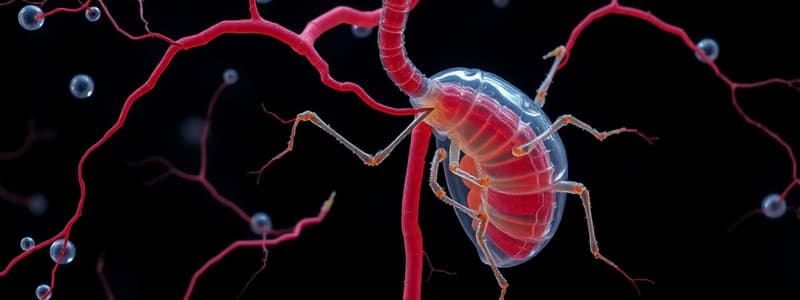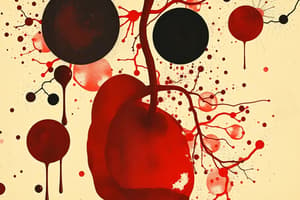Podcast
Questions and Answers
Which of the following best describes the primary function of the endothelium in blood vessels?
Which of the following best describes the primary function of the endothelium in blood vessels?
- Regulation of blood pressure and flow through smooth muscle contraction.
- Providing structural support with collagen fibers.
- Acting as an elastic layer that expands under high pressure.
- Facilitating exchange across capillaries and regulating blood clotting. (correct)
Why do arteries located near the heart have a thicker tunica externa compared to distal arteries?
Why do arteries located near the heart have a thicker tunica externa compared to distal arteries?
- To facilitate regulation of blood pressure via smooth muscle.
- To assist in the backflow of blood in the opposite direction.
- To accommodate the high pressure and act as a pressure reservoir. (correct)
- To increase blood flow resistance.
What is the main function of tunica media in blood vessels, such as in muscular arteries?
What is the main function of tunica media in blood vessels, such as in muscular arteries?
- Regulating blood pressure and flow through smooth muscle and elastin. (correct)
- Serving as the primary site for blood exchange.
- Providing structural support using collagen fibers.
- Preventing blood backflow.
Compared to arteries, what is the main characteristic of venous composition?
Compared to arteries, what is the main characteristic of venous composition?
Arterioles, compared to other arteries, are characterized by which of the following?
Arterioles, compared to other arteries, are characterized by which of the following?
In a closed circulatory system, what fluid directly bathes the tissue cells?
In a closed circulatory system, what fluid directly bathes the tissue cells?
What is the primary function of the 'cardio' component of a circulatory system?
What is the primary function of the 'cardio' component of a circulatory system?
Which characteristic distinguishes an open circulatory system from a closed circulatory system?
Which characteristic distinguishes an open circulatory system from a closed circulatory system?
What are the spaces within tissues where hemolymph is collected called?
What are the spaces within tissues where hemolymph is collected called?
Which of the following best describes the circulatory system of insects?
Which of the following best describes the circulatory system of insects?
Which of these is a characteristic of an arthropod circulatory system?
Which of these is a characteristic of an arthropod circulatory system?
What role do lacunae play in hemolymph circulation?
What role do lacunae play in hemolymph circulation?
What is the main purpose of the internal circulating fluid in animals?
What is the main purpose of the internal circulating fluid in animals?
Flashcards
Endothelium
Endothelium
The lining of blood vessels that allows for exchange of substances, regulates blood clotting, and contributes to blood pressure control.
Tunica Media
Tunica Media
The middle layer of blood vessels, composed of smooth muscle and elastin, playing a crucial role in regulating blood pressure and flow.
Tunica Externa
Tunica Externa
The outermost layer of blood vessels, mostly made of collagen, providing structural support and flexibility.
Elastic Arteries
Elastic Arteries
Signup and view all the flashcards
Muscular Arteries
Muscular Arteries
Signup and view all the flashcards
Fluid
Fluid
Signup and view all the flashcards
Fluid Circulation
Fluid Circulation
Signup and view all the flashcards
Circulatory System
Circulatory System
Signup and view all the flashcards
Pump (Circulatory System)
Pump (Circulatory System)
Signup and view all the flashcards
Tubes (Circulatory System)
Tubes (Circulatory System)
Signup and view all the flashcards
Internal Fluid (Circulatory System)
Internal Fluid (Circulatory System)
Signup and view all the flashcards
Closed Circulatory System
Closed Circulatory System
Signup and view all the flashcards
Open Circulatory System
Open Circulatory System
Signup and view all the flashcards
Study Notes
Lecture 9: Circulatory Systems
- Open vs. Closed Circulatory Systems discussed
- Vessel characteristics were reviewed
- Reading assignments: pages 700-706 and 714-721
Fluid Circulation (Convection)
- Definition of "fluid"
- Fluids circulated within animals: blood, hemolymph
- Mechanisms of fluid circulation
Components of Circulatory System
- Pumps (e.g., heart) generate pressure to move fluid through tubes
- Tubes (vessels): open or closed circulatory vascular systems
- Internal fluid (e.g., blood, hemolymph) exchanging substances with external environment, while remaining within the animal
Classification of Circulatory Systems
- Closed: Vessels separate fluid from tissues; fluid stays within vessels; exchange by diffusion/transport across vessel walls.
- Open: Fluid leaves discrete vessels; fluid bathes tissues directly
All Arthropods Have Open Systems
- They differ in complexity
- Examples of arthropods: insects, other invertebrates
Athleticism & Closed Systems?
- Insects have simple, open systems, but highest metabolic rate in animal kingdom
- How (insects): body movements facilitate circulation, with extensive arteries and even "capillaries"
Closed System Vessels: Vertebrates
- Different vessel types (e.g., large vein, elastic artery, muscular artery, venule, arteriole, capillary) and their components (e.g., tunica externa, tunica media, tunica intima, endothelium)
Blood Vessel Components
- Endothelium: epithelial lining; exchanges across capillaries, regulates blood clotting, and blood pressure/flow
- Tunica media: smooth muscle and elastin; regulating blood pressure/flow
- Tunica externa: collagen
Arterial Components
- Arteries near the heart: thick tunica externa, elastic, expands at high pressure
- Arteries distal from heart have thick tunica media ("muscular arteries")
- Arterioles: little tunica externa, still tunica media; lower pressure, higher resistance, large control over blood flow
Venous Components
- Much lower pressure, can fall to 0
- Thinner tunica media, but thick-ish tunica externa
- Stretchy, with valves to prevent backflow
What happens to blood components that leave circulation?
- Blood components leaving circulation may enter lymphatic systems
- Fluid exchange may occur between blood and interstitial spaces of tissues.
Studying That Suits You
Use AI to generate personalized quizzes and flashcards to suit your learning preferences.





